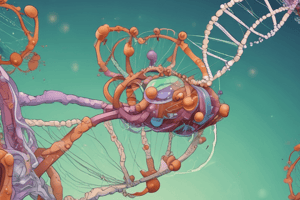Podcast
Questions and Answers
What is the function of the dependent variable in an experiment?
What is the function of the dependent variable in an experiment?
- It is what you are manipulating to affect the independent variable
- It provides predictable outcomes
- It is what you are measuring or what you care about (correct)
- It tells us baseline information about the dependent variable
Which scientists discovered that enzymes that destroy DNA and proteins respectively?
Which scientists discovered that enzymes that destroy DNA and proteins respectively?
- Frederick Griffith
- Dr. Grabiner
- Oswald Avery, Colin MacLeod and Maclyn McCarty (correct)
- Celine [email protected]
What was the outcome of mixing harmless bacteria with material from heat-killed dangerous bacteria, as observed by Frederick Griffith?
What was the outcome of mixing harmless bacteria with material from heat-killed dangerous bacteria, as observed by Frederick Griffith?
- The dangerous bacteria became harmless (correct)
- The dangerous bacteria multiplied rapidly
- Nothing happened
- The harmless bacteria died
Which variable in an experiment provides baseline information about the dependent variable?
Which variable in an experiment provides baseline information about the dependent variable?
What does the independent variable represent in an experiment?
What does the independent variable represent in an experiment?
"What is genetic material?" falls under which topic in the syllabus?
"What is genetic material?" falls under which topic in the syllabus?
Which group of scientists conducted an experiment involving mixing harmless bacteria with material from heat-killed dangerous bacteria?
Which group of scientists conducted an experiment involving mixing harmless bacteria with material from heat-killed dangerous bacteria?
What is the role of enzymes that destroy DNA and proteins, as mentioned in the text?
What is the role of enzymes that destroy DNA and proteins, as mentioned in the text?
What is the effect of a difference in 1 amino acid of the 300 amino acids that make up the beta subunit in Sickle Cell Disease?
What is the effect of a difference in 1 amino acid of the 300 amino acids that make up the beta subunit in Sickle Cell Disease?
What is the role of the 5’ carbon atom of the sugar in DNA?
What is the role of the 5’ carbon atom of the sugar in DNA?
Which nitrogenous base is a purine?
Which nitrogenous base is a purine?
Which type of bond holds the two strands of DNA together?
Which type of bond holds the two strands of DNA together?
What does Erwin Chargaff's work in 1952 primarily contribute to in genetics?
What does Erwin Chargaff's work in 1952 primarily contribute to in genetics?
What is the function of most cellular processes that depend on proteins?
What is the function of most cellular processes that depend on proteins?
Study Notes
Experimental Design
- The dependent variable is the outcome or response being measured in an experiment.
- The independent variable represents the factor being manipulated or changed in an experiment.
- The controlled variable provides baseline information about the dependent variable.
Griffith's Experiment
- Frederick Griffith mixed harmless bacteria with material from heat-killed dangerous bacteria, resulting in the transformation of the harmless bacteria into a pathogenic form.
- This experiment was conducted by a group of scientists, including Frederick Griffith.
Enzymes
- Enzymes that destroy DNA and proteins, respectively, were discovered by scientists.
- These enzymes play a role in destroying DNA and proteins.
DNA Structure
- The 5’ carbon atom of the sugar in DNA plays a crucial role in its structure.
- The two strands of DNA are held together by hydrogen bonds.
- Adenine (A) is a purine nitrogenous base.
Sickle Cell Disease
- A difference in 1 amino acid of the 300 amino acids that make up the beta subunit leads to Sickle Cell Disease.
Genetics
- The question "What is genetic material?" falls under the topic of genetics.
- Erwin Chargaff's work in 1952 primarily contributed to the understanding of the structure of DNA in genetics.
Proteins
- Most cellular processes that depend on proteins are essential for maintaining cellular function.
Studying That Suits You
Use AI to generate personalized quizzes and flashcards to suit your learning preferences.
Description
This quiz covers the introduction to Genetics and Molecular Biology, including topics like DNA function, DNA structure, genome and chromosome structure, and RNA structure. It also includes syllabus information and an introduction to the course.




